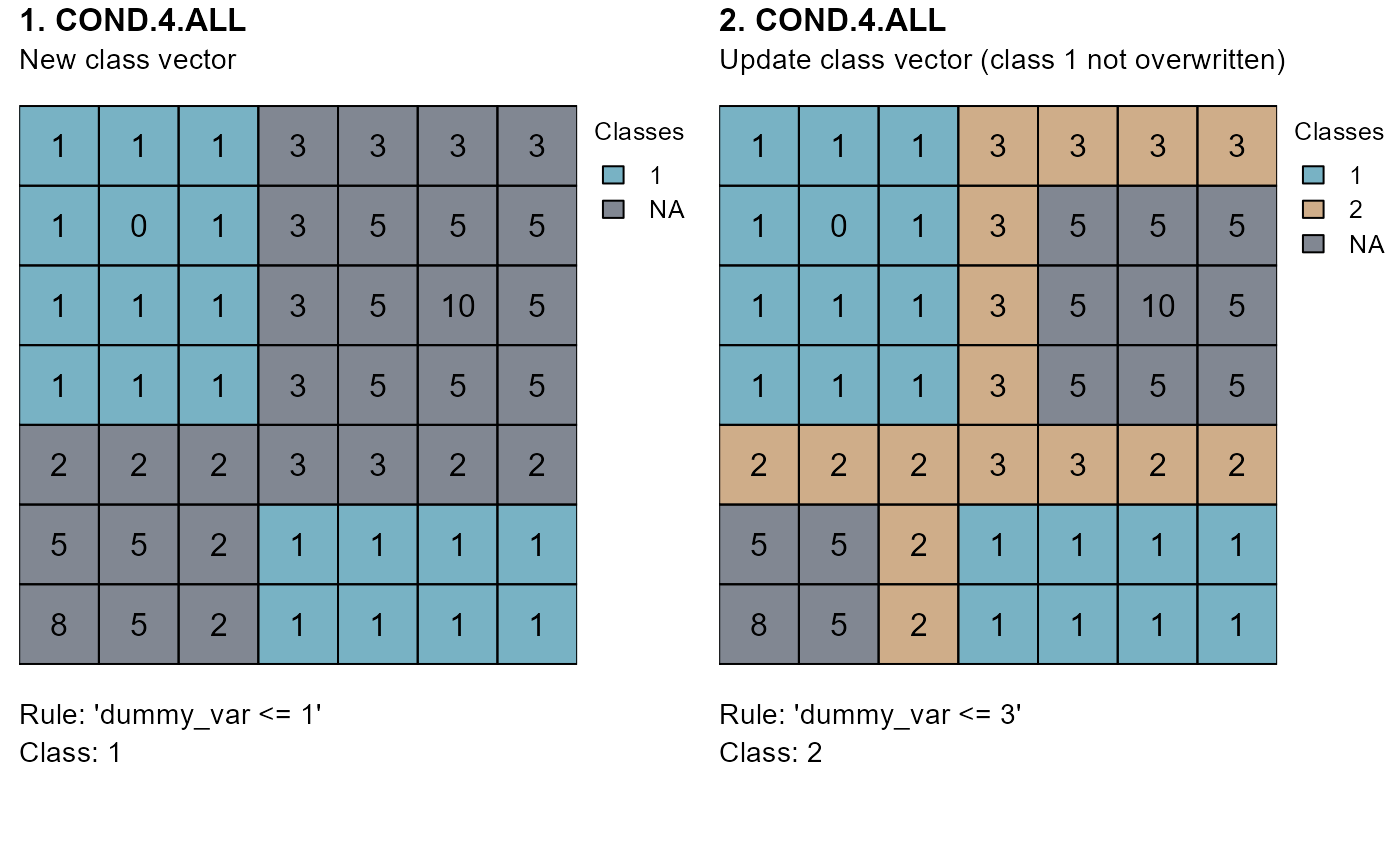Evaluate conditions for unclassified cells and classify them if conditions are true.
cond.4.all(attTbl, cond, classVector = NULL, class, ovw_class = FALSE)Arguments
- attTbl
data.frame, the attribute table returned by the function
attTbl.- cond
character string, the conditions a cell have to meet to be classified as indicated by the argument
class. If there is aclassVectorinput, the classification number is only assigned to unclassified cells unless the argumentovw_class = TRUE. Seeconditionsfor more details.- classVector
numeric vector, if provided, it defines the cells in the attribute table that have already been classified. See
conditionsfor more information about class vectors.- class
numeric, the classification number to assign to all cells that meet the function conditions.
- ovw_class
logic, if there is a
classVectorinput, reclassify cells that were already classified and that meet the function conditions.
Value
Update classVector with the new cells that were classified by
the function. If there is no classVector input, the function returns
a new class vector. See conditions for more details about
class vectors.
Details
The function evaluates the conditions of the argument
conditionsfor all unclassified cells (i.e.,classVectorNA-cells).Cells that meet the function conditions are classified as indicted by the argument
class.Absolute test cell conditions can be used (see
conditions).
See also
Examples
# DUMMY DATA
################################################################################
library(scapesClassification)
library(terra)
# LOAD THE DUMMY RASTER
r <- list.files(system.file("extdata", package = "scapesClassification"),
pattern = "dummy_raster\\.tif", full.names = TRUE)
r <- terra::rast(r)
# COMPUTE THE ATTRIBUTE TABLE
at <- attTbl(r, "dummy_var")
# COMPUTE THE LIST OF NEIGBORHOODS
nbs <- ngbList(r)
################################################################################
# COND.4.ALL
################################################################################
# compute new class vector
# conditions: "dummy_var == 1"
cv1 <- cond.4.all(attTbl = at, cond = "dummy_var <= 1", class = 1)
unique(cv1) # one class (class 1)
#> [1] 1 NA
# update class vector `cv1`
# conditions: "dummy_var <= 3"
cv2 <- cond.4.all(attTbl = at, cond = "dummy_var <= 3", class = 2,
classVector = cv1) # input previous class vector
unique(cv2) # two classes (class 1 and class 2)
#> [1] 1 2 NA
# convert class vector 2 raster
r_cv1 <- cv.2.rast(r, at$Cell, classVector = cv1)
r_cv2 <- cv.2.rast(r, at$Cell, classVector = cv2)
################################################################################
# PLOTS
################################################################################
oldpar <- par(mfrow = c(1,2))
m <- c(4.5, 0.5, 2, 3.2)
# 1.
r_cv1[which(is.na(values(r_cv1)))] <- 10
plot(r_cv1, type="classes", mar=m, col=c("#78b2c4","#818792"), axes=FALSE,
plg=list(x=1, y=1, cex=.80, title="Classes",legend=c("1", "NA")))
text(r); lines(r)
mtext(side=3, line=1, adj=0, cex=1, font=2, "1. COND.4.ALL")
mtext(side=3, line=0, adj=0, cex=0.9, "New class vector")
mtext(side=1, line=0, cex=0.9, adj=0, "Rule: 'dummy_var <= 1'")
mtext(side=1, line=1, cex=0.9, adj=0, "Class: 1")
# 2.
r_cv2[which(is.na(values(r_cv2)))] <- 10
plot(r_cv2, type="classes", mar=m, col=c("#78b2c4","#cfad89","#818792"), axes=FALSE,
plg=list(x=1, y=1, cex=.80, title="Classes",legend=c("1", "2", "NA")))
text(r); lines(r)
mtext(side=3, line=1, adj=0, cex=1, font=2, "2. COND.4.ALL")
mtext(side=3, line=0, adj=0, cex=0.9, "Update class vector (class 1 not overwritten)")
mtext(side=1, line=0, cex=0.9, adj=0, "Rule: 'dummy_var <= 3'")
mtext(side=1, line=1, cex=0.9, adj=0, "Class: 2")
 par(oldpar)
par(oldpar)